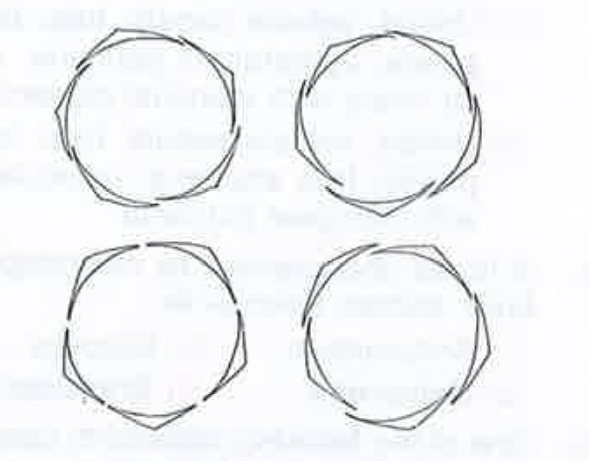Draw the various types of aestivation possible for a typical pentamerous flower.
To answer the question about the various types of aestivation possible for a typical pentamerous flower, we will follow these steps:
1. Understand Aestivation: Aestivation refers to the arrangement of sepals or petals in a floral bud. It's important to know that it describes how these parts overlap or align with each other before the flower blooms.
2. Identify Types of Aestivation:
- Valvate Aestivation: In this type, the sepals or petals are arranged in a single whorl and just touch each other at the margins. This type can be visualized as a wall where each part meets the next without overlapping. An example of this is found in the flower of Calotropis.
- Twisted Aestivation: Here, one margin of each petal or sepal overlaps the next one in a spiral manner. This can be illustrated as a series of petals where each one twists over the next. A common example is the China rose.
- Imbricate Aestivation: In this arrangement, the petals or sepals overlap each other but not in a regular pattern. This can be visualized as petals that cover each other in a somewhat haphazard manner. The Gulmohar flower exhibits this type of aestivation.
- Quincuncial Aestivation: In this type, there are five petals where two are completely outside, two are completely inside, and one is partially outside. This arrangement can be drawn to show how the petals are positioned relative to one another. An example is the flower of Ranunculus.
- Vexillary Aestivation: This is a specific arrangement seen in legumes where one large petal (vexillum) overlaps two lateral petals (wings), which in turn overlap the smallest petal (keel). This can be illustrated by drawing the petals in a way that shows this specific hierarchy.
3. Draw the Diagrams: For each type of aestivation, draw a diagram that represents the arrangement of the petals or sepals. Label each type clearly.
4. Label the Examples: Next to each diagram, write down the name of a flower that exhibits that particular type of aestivation.
- Valvate Aestivation: In this type, the sepals or petals are arranged in a single whorl and just touch each other at the margins. This type can be visualized as a wall where each part meets the next without overlapping. An example of this is found in the flower of Calotropis.
- Twisted Aestivation: Here, one margin of each petal or sepal overlaps the next one in a spiral manner. This can be illustrated as a series of petals where each one twists over the next. A common example is the China rose.
- Imbricate Aestivation: In this arrangement, the petals or sepals overlap each other but not in a regular pattern. This can be visualized as petals that cover each other in a somewhat haphazard manner. The Gulmohar flower exhibits this type of aestivation.
- Quincuncial Aestivation: In this type, there are five petals where two are completely outside, two are completely inside, and one is partially outside. This arrangement can be drawn to show how the petals are positioned relative to one another. An example is the flower of Ranunculus.
- Vexillary Aestivation: This is a specific arrangement seen in legumes where one large petal (vexillum) overlaps two lateral petals (wings), which in turn overlap the smallest petal (keel). This can be illustrated by drawing the petals in a way that shows this specific hierarchy.
Topper's Solved these Questions
- MORPHOLOGY OF FLOWERING PLANTS BOOK - ICSECHAPTER - MORPHOLOGY OF FLOWERING PLANTS EXERCISE - Test Your Progress (HOTS)
4 Videos
- MORPHOLOGY OF FLOWERING PLANTS BOOK - ICSECHAPTER - MORPHOLOGY OF FLOWERING PLANTS EXERCISE - Ncert Exercises with Answers
25 Videos
- MORPHOLOGY OF FLOWERING PLANTS BOOK - ICSECHAPTER - MORPHOLOGY OF FLOWERING PLANTS EXERCISE - Test Your Progress (Very Short Answer Type Questions )
35 Videos
- MORPHOLOGY AND ANATOMY OF DIFFERENT SYSTEM OF COCKROACH BOOK - ICSECHAPTER - MORPHOLOGY AND ANATOMY OF DIFFERENT SYSTEM OF COCKROACH EXERCISE - Long Answer type Questions
6 Videos
- NEURAL CONTROL AND CO-ORDINATION BOOK - ICSECHAPTER - NEURAL CONTROL AND CO-ORDINATION EXERCISE - NCERT EXERCISES WITH ANSWER (DIFFERENTIATE BETWEEN)
11 Videos
Similar Questions
What are various types of parasites?
View SolutionWhich type of aestivation is found in Pea?
View SolutionName various types of Co-factors.
View SolutionWhat type of aestivation is seen in a papilionaceous corolla?
View SolutionDescribe the various types of placentations found in flowering plants.
View SolutionDescribe the various types of placentations found in flowering plants.
View SolutionName various types of cells present in xylem.
View SolutionWhat are the various types of wave? Give examples.
View SolutionWhich type of aestivation is shown in the diagram ?

View SolutionExplain various types of senescence.
View Solution
